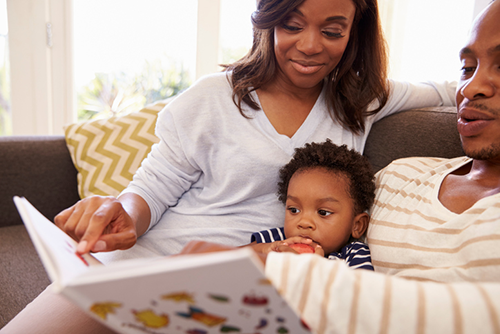7 Myths About Reading to Your Child
Myth #1: My child is too young. He won’t sit through a whole story! It’s never too early to start reading to your child. In fact, many experts recommend building the habit of reading together while your child is still in the womb. Studies show that babies develop their sense of hearing around the beginning […]

Myth #1: My child is too young. He won’t sit through a whole story!

It’s never too early to start reading to your child. In fact, many experts recommend building the habit of reading together while your child is still in the womb. Studies show that babies develop their sense of hearing around the beginning of the third trimester and are soothed by the sound of their mother’s voice. Reading is a perfect way to provide that comfort.
If your wiggly infant or toddler doesn’t seem interested in what you’re reading, keep in mind that little ones listen in different ways. Dancing around, chewing on the book, or babbling in the background are all a-okay. The only behavior that isn’t is crying. Reading should always be a positive experience. If your child is upset, don’t force it. Simply try again later.
Myth #2: My child just wants to make up her own story.
Picture books never fail to spark a child’s imagination, and many children feel inspired to tell their own stories based on a book’s illustrations. While this may not seem productive, narration is actually an important aspect of reading together and practice narrating a story is beneficial to your child’s development. Storytelling helps her cultivate narrative fluency, language skills, and an understanding of real and make-believe.
If you have an avid storyteller on your hands, make the most of this process by asking questions and encouraging your child to think empathetically about how characters are feeling. And don’t forget to check out a variety of wordless picture books!
Myth #3: My child reads on his own, so reading aloud to him doesn’t make a difference.

There are no age restrictions for reading to your child. Reading aloud to older, independent readers has both educational and emotional benefits. A child’s reading level doesn’t quite catch up to his listening level until about age 14. Being read to helps expose kids to more complex ideas and prepares them to tackle more challenging texts. Reading to an older child also helps keep a love of reading alive that he can carry into his teen and adult years.
Myth #4: Reading the same book over and over is driving me crazy and isn’t helping my child.
Well, the first part may be true, but research suggests that repetitive reading is actually beneficial to emerging readers. Each time you read your child’s favorite book to her, she recognizes new words, picks up on language patterns, and develops a deeper understanding of the story.
If you’ve got the book memorized and are tempted to make it disappear, try asking what if and why questions as you read to liven up the story: What if the big bad wolf got a fan to help him with the brick house? Why are the three little pigs feeling scared? If you’re still eager to introduce some variety into your reading
routine, make a deal: your child can choose a favorite to read together, but you also get to pick one of yours—or a brand new book to try!
Myth #5: My child hates to read.

“If you don’t like to read, you haven’t found the right book.” – J.K. Rowling
Sharing and hearing stories is a huge part of who we are. Deep down, everyone loves to read. It’s just a matter of finding what book taps into your child’s passion.
If you have a reluctant reader on your hands, try bringing him to your local library to browse. The best thing you can do to get your child excited about reading is putting the power in his hands and letting him pick his own books. Still having trouble? Try scooping up books with popular T.V. characters or books that connect to other activities he loves (video games, sports, music, etc.). If you’re unsure of where to start, ask the children’s librarian. Librarians are experts at getting the perfect book in your child’s hands.
Myth #6: My child refuses to read “real books.”
While it’s beneficial to encourage your child to challenge her reading level by picking up text-only chapter books, remember that books come in all kinds of shapes, sizes, and styles that are all valuable to developing readers. There’s really no such thing as a “real” book! In fact, comics, graphic novels, and diary-style fiction all help children develop visual literacy skills that are essential to succeeding as 21st century learner.
Pushing books that seem to be better quality over titles your child is drawn to can turn reading into a chore. Keeping the love for reading alive and exposing your child to a variety of books are really what matter most.
Myth #7: We have plenty of books at home, so my child doesn’t need to check out anything from the library.

Many studies have shown that having books in the home is strongly linked to academic achievement. Having a home library is a truly a wonderful thing, but your local library still has a lot to offer. While there are both spatial and financial limits to how many books your home can hold, your child’s curiosity, creativity, and aptitude are limitless.
Libraries offer the chance for your child to discover new interests, try out the hottest new titles, and fully tap into the power of her imagination—all at no cost. There is no such thing as too many books! Why not take advantage of every resource to help you child dream, create, and grow?
by: Rebecca Price-Donahue

